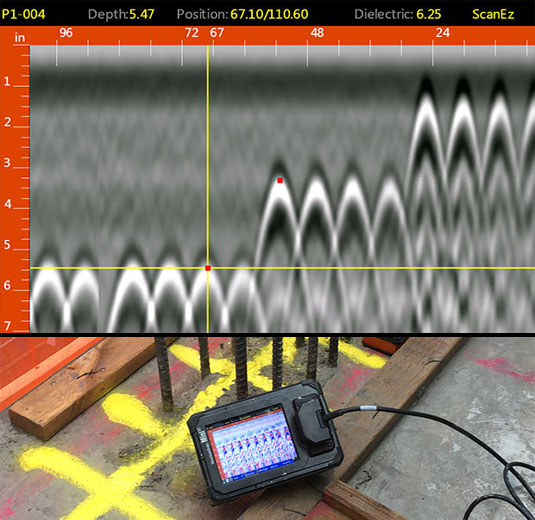Advanced Concrete Scanning Techniques: Guaranteeing Architectural Stability
Advanced Concrete Scanning Techniques: Guaranteeing Architectural Stability
Blog Article
Introduce the Transformative Power of Concrete Scanning in Taking Full Advantage Of Effectiveness and Security
Concrete scanning has emerged as a crucial tool in the building and construction industry, providing unparalleled advantages in enhancing job performance and making sure security criteria. The transformative power of concrete scanning exists in its capability to supply real-time data and in-depth understandings, changing just how tasks are prepared and implemented.
Relevance of Concrete Scanning
Ensuring the structural integrity and security of construction projects begins with the crucial action of conducting comprehensive concrete scanning. Concrete scanning is a non-destructive technique utilized to detect and map subsurface components within concrete structures. This procedure is vital in determining possible dangers, such as rebar, post-tension cable televisions, and channels, that may be hidden within the concrete. By using advanced technologies like ground-penetrating radar (GPR) and electromagnetic induction, construction teams can precisely locate these elements without causing any type of damages to the structure.
The importance of concrete scanning can not be overstated, as it plays an important role in stopping accidents, minimizing task delays, and guaranteeing the long-lasting longevity of the construction. By recognizing prospective threats prior to the construction stage starts, home builders can carry out ideal precaution and make informed decisions regarding the layout and execution of the project. Additionally, concrete scanning aids in enhancing job timelines and spending plan by staying clear of unforeseen expenses and hold-ups that might occur because of unanticipated obstructions within the concrete. Inevitably, purchasing extensive concrete scanning is a positive strategy that enhances both efficiency and safety and security in building tasks.
How Concrete Scanning Works
Concrete scanning operates as an important tool in construction projects by using advanced technologies to identify and map subsurface components without triggering architectural damage. Ground Passing Through Radar (GPR) and Electromagnetic Induction (EMI) are two key techniques utilized in concrete scanning.
During the scanning procedure, the information gathered is examined in real-time, enabling instant recognition of potential risks or barriers under the surface. This info aids in decision-making, making sure that building and construction activities continue safely and efficiently. In addition, 3D imaging software program can be utilized to develop in-depth maps of the subsurface elements, better improving job planning and execution. By using these innovative modern technologies, concrete scanning dramatically reduces the threat of costly problems and injuries on construction websites.
Benefits of Concrete Scanning
One of the main advantages of concrete scanning is the capacity to spot and locate embedded things such as rebar, post-tension cables, and conduits properly. Concrete scanning assists in planning and creating more efficiently, as it gives precise information regarding the place and depth of structural parts.

Study: Concrete Scanning Success

In another case, a construction company made use of 3D concrete scanning to examine the problem of aging concrete frameworks in a historic structure. The thorough scans given useful understandings into the degree of wear and tear and aided focus on find out here upkeep initiatives effectively. By proactively dealing with areas of problem recognized through scanning, the company was able to extend the lifespan of the structure and ensure passenger security.
These instance researches emphasize the transformative power of concrete scanning in improving performance, accuracy, and safety and security in building jobs.
Carrying Out Concrete Scanning in Projects
Executing innovative scanning technologies throughout construction tasks has actually ended up being progressively important for boosting precision and security. By integrating concrete scanning right into job preparation and execution, building and webpage construction groups can recognize prospective dangers, such as rebar or post-tension cords, hidden within concrete frameworks. This positive approach reduces the risk of accidents, delays, and expensive rework, ultimately causing extra efficient task timelines and spending plans.
To execute concrete scanning properly, job supervisors need to collaborate very closely with experienced scanning professionals to identify the most appropriate scanning methods for the details job requirements. Engaging scanning experts from the beginning of a task allows the team to create thorough scanning strategies that attend to crucial locations of issue and ensure thorough information collection.
Furthermore, incorporating concrete scanning into regular project operations can enhance decision-making procedures, as real-time scan information offers prompt understandings right into the problem of concrete frameworks - Concrete Scanning. This data-driven method facilitates notified problem-solving and makes it possible for teams to make modifications without delay, cultivating a culture of efficiency and security throughout the task lifecycle

Final Thought
In verdict, concrete scanning plays a vital role in improving performance and safety in building and construction tasks. By making use of innovative modern technology to map and find out underlying frameworks within concrete, this procedure helps to avoid expensive errors, make certain architectural stability, and minimize risks on site. With the capacity to reveal covert elements and give accurate information, concrete scanning verifies to be a beneficial device for maximizing task outcomes and making best use of general find out this here success.
Concrete scanning is a non-destructive technique utilized to discover and map subsurface components within concrete frameworks. In addition, concrete scanning aids in maximizing job timelines and spending plan by preventing unforeseen expenses and hold-ups that might arise due to unforeseen obstructions within the concrete. One notable case research study involves a massive remodelling project where concrete scanning played a critical function in ensuring project success.In one more situation, a building and construction company utilized 3D concrete scanning to assess the problem of aging concrete structures in a historic structure. By integrating concrete scanning right into project planning and execution, building teams can identify potential hazards, such as rebar or post-tension cords, concealed within concrete frameworks.
Report this page